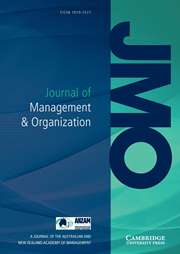Article contents
Workplace ostracism and team members’ creativity: The mediating role of self-reflection and moderating role of high-involvement work practices
Published online by Cambridge University Press: 26 April 2022
Abstract
Drawing on social cognitive theory, this paper examines whether self-reflection mediates the association between workplace ostracism and team members’ creativity, and whether this mediating effect is moderated by high-involvement work practices (HIWPs). We construct and test a cross-level model using multilevel path analysis to analyse data collected from 81 teams (a total of 393 members) in China. The results show that workplace ostracism negatively influences team members’ reflection but positively influences rumination, which in turn affects individual creativity. Furthermore, HIWPs negatively moderate the effects of workplace ostracism on self-reflection, and moderate the linkages among workplace ostracism, reflection/rumination and team members’ creativity. Finally, theoretical and practical implications of these findings are discussed.
Information
- Type
- Research Article
- Information
- Copyright
- © Cambridge University Press and Australian and New Zealand Academy of Management 2022.
References
- 6
- Cited by

